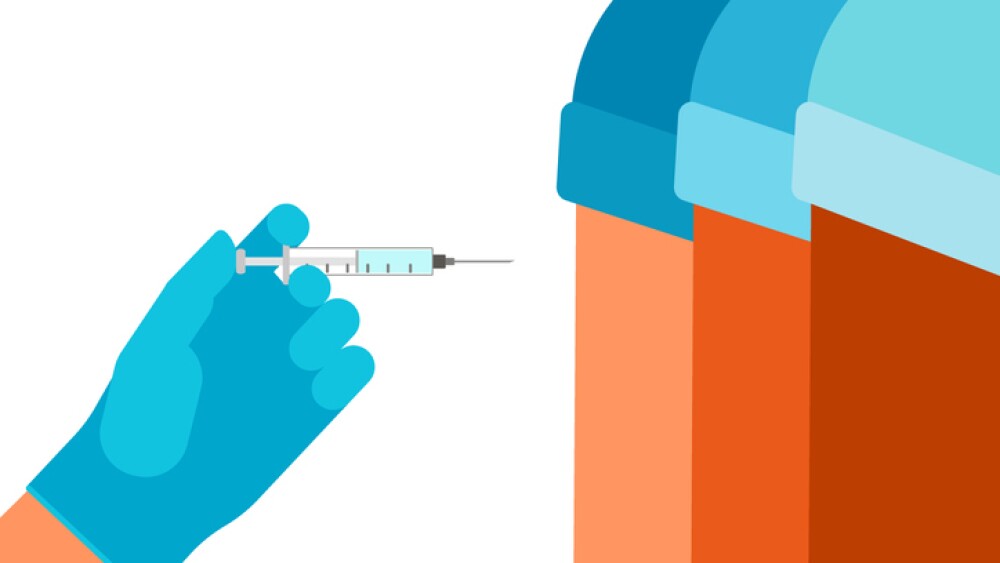Protagonist Therapeutics (Nasdaq: PTGX) (“Protagonist” or “the Company”) today announced results from a Phase 2a study in which rusfertide, an investigational new drug, is being evaluated for the treatment of hereditary hemochromatosis (HH).
|
NEWARK, Calif., Nov. 15, 2021 /PRNewswire/ -- Protagonist Therapeutics (Nasdaq: PTGX) ("Protagonist" or "the Company") today announced results from a Phase 2a study in which rusfertide, an investigational new drug, is being evaluated for the treatment of hereditary hemochromatosis (HH). HH is a genetic disorder arising from a deficiency or dysregulation of the natural hormone hepcidin, a condition which causes the body to absorb too much iron. The clinical data from the study were presented in an oral presentation at The Liver Meeting® of the American Association for the Study of Liver Diseases (AASLD). "Despite its prevalence, no drug therapies have been developed to date for the treatment of hereditary hemochromatosis," said Kris V. Kowdley, M.D., Director of Liver Institute Northwest, Professor at the Elson S. Floyd College of Medicine at Washington State University, an author of the ACG Guidelines for HH, and the study's principal investigator. "I'm encouraged by the efforts Protagonist has undertaken in this area of iron overload diseases, and specifically by the Phase 2 data that demonstrates rusfertide's therapeutic effect by several different measures, including pharmacodynamic effects, reduction in phlebotomy requirements, stabilization of liver iron content, and possible improvements in quality-of-life measures. Hereditary hemochromatosis is characterized by low levels of hepcidin, with variability of severity in clinical manifestations across different patient sub-populations. Rusfertide has the potential to offer a treatment option for patients in whom phlebotomy may be difficult or contraindicated." "Rusfertide has the potential to be the first-in-class drug therapy for an HH indication," said Dinesh Patel, Ph.D., President and Chief Executive Officer of Protagonist. "After polycythemia vera, this marks a second indication where rusfertide has demonstrated a positive clinical proof-of-concept, thereby signaling a broader potential utility to address unmet needs of patients in these diseases. The study results announced at AASLD will serve as an important foundation for the next steps that we will determine in consultation with key clinical investigators and regulatory agencies. Going forward, our focus will be on proving rusfertide's potential to address unmet medical needs in specific subpopulations of HH." Study Design and Summary of Results:
About Hereditary Hemochromatosis Hereditary hemochromatosis (HH) is a genetic disorder characterized by excessive iron absorption due to a deficiency or dysregulation in hepcidin. The disorder results in the accumulation of excess iron in the body's organs. Approximately one million people in the United States have HFE mutations consistent with type 1 HH; out of these, 10 to 15 percent develop clinical manifestations of the disease. The clinical symptoms of hemochromatosis usually appear after significant iron accumulation—generally after the age of 40. Early signs are nonspecific and can include weakness, lethargy, increased skin pigmentation, hair loss, impotence, joint pains, vertigo, and loss of memory. In HH types 1-3, mutations in genes encoding hepcidin regulators or hepcidin itself lead to diminished production of hepcidin, thus decreasing the inhibitory effect of hepcidin on duodenal iron absorption and causing clinical iron overload (Brissot 2011). Hepcidin deficiency leads to increased circulating transferrin saturation, and ultimately, iron accumulation in organs such as the liver, pancreas, heart, and bone. Iron in excess may induce or favor the development of complications such as cirrhosis, liver cancer, diabetes, heart failure, hypogonadism, but also, complaints such as asthenia and disabling arthritis. The goal of treatment in HH patients is to reduce the development of such complications. Per ACG Guidelines, patients with elevated serum ferritin above 200 ng/mL in females and 300 ng/mL in males along with a transferrin saturation (TSAT) at or above 45 percent will require treatment to reduce serum ferritin to the range of 50-100 ng/mL and subsequently decrease TSAT levels to below 45 percent. There is no approved medicine for treatment of HH, and phlebotomy continues to be the main treatment option. Patients living with clinical manifestations of HH require continued phlebotomies for their entire lives to limit end-organ damage. While therapeutic phlebotomy is effective in removing excess iron and preventing most of the complications associated with excess iron in the body, this treatment does not target the biological mechanisms leading to iron metabolism disturbance. Approximately 25% of patients in maintenance felt that receiving phlebotomies was "inconvenient" or "very inconvenient" (Brissot 2011), and patient compliance with phlebotomies generally declines over time (Hicken et al, 2003). In hepcidin-deficient mouse models of hemochromatosis, a mini-hepcidin and rusfertide were found to be effective in decreasing iron loading in the liver compared to vehicle treated control mice that were iron overloaded (Ramos 2012, Taranath 2019). These pre-clinical observations along with our clinical findings in the current study suggest that a hepcidin mimetic such as rusfertide may be effective for preventing iron overload in patients with hemochromatosis. About Protagonist Protagonist Therapeutics is a biopharmaceutical company with multiple peptide-based investigational new chemical entities in different stages of development, all derived from the Company's proprietary technology platform. Protagonist's pipeline includes rusfertide (PTG-300), an investigational, injectable hepcidin mimetic currently in a Phase 2 proof-of-concept clinical trial for polycythemia vera (PV), a Phase 2 study in PV subjects with high hematocrit levels, and a Phase 2a study for hereditary hemochromatosis. The Company plans to initiate a single, global Phase 3 randomized, placebo-controlled trial evaluating the efficacy and safety of a once weekly, subcutaneously self-administered dose of rusfertide. The Company is also evaluating an orally delivered, gut-restricted alpha-4-beta-7 integrin specific antagonist peptide (PN-943) currently in a Phase 2 study in adults with moderate to severe active ulcerative colitis (UC). The Company is targeting ulcerative colitis as the initial indication. The Company has a worldwide license and collaboration agreement with Janssen Biotech, Inc., for the development of oral peptide IL-23 receptor antagonists. Compounds in development include PN-235 and PN-232, both second-generation oral interleukin-23 receptor antagonist candidates. The Phase 1 study of PN-235 is completed, and Janssen is expected to initiate a Phase 2 study in psoriasis in early 2022. The Phase 1 study with PN-232 is in progress, with study completion expected by mid-2022. Additional clinical development in IBD is expected to initiate in 2022. Cautionary Note on Forward-Looking Statements This press release contains forward-looking statements for purposes of the safe harbor provisions of the Private Securities Litigation Reform Act of 1995. Forward-looking statements include statements regarding our intentions or current expectations concerning, among other things, the Company's clinical development program for rusfertide in HH, and the potential benefits of rusfertide in HH patients. In some cases, you can identify these statements by forward-looking words such as "anticipate," "believe," "may," "will," "expect," or the negative or plural of these words or similar expressions. Forward-looking statements are not guarantees of future performance and are subject to risks and uncertainties that could cause actual results and events to differ materially from those anticipated, including, but not limited to, our ability to develop and commercialize our product candidates, our ability to earn milestone payments under our collaboration agreements, the impact of the current COVID-19 pandemic on our discovery and development efforts, our ability to use and expand our programs to build a pipeline of product candidates, our ability to obtain and maintain regulatory approval of our product candidates, our ability to operate in a competitive industry and compete successfully against competitors that have greater resources than we do, and our ability to obtain and adequately protect intellectual property rights for our product candidates. Additional information concerning these and other risk factors affecting our business can be found in our periodic filings with the Securities and Exchange Commission, including under the heading "Risk Factors" contained in our most recently filed periodic reports on Form 10-K and Form 10-Q filed with the Securities and Exchange Commission. Forward-looking statements are not guarantees of future performance, and our actual results of operations, financial condition and liquidity, and the development of the industry in which we operate, may differ materially from the forward-looking statements contained in this press release. Any forward-looking statements that we make in this press release speak only as of the date of this press release. We assume no obligation to update our forward-looking statements, whether as a result of new information, future events or otherwise, after the date of this press release.
SOURCE Protagonist Therapeutics, Inc. |
||
Company Codes: NASDAQ-NMS:PTGX |





